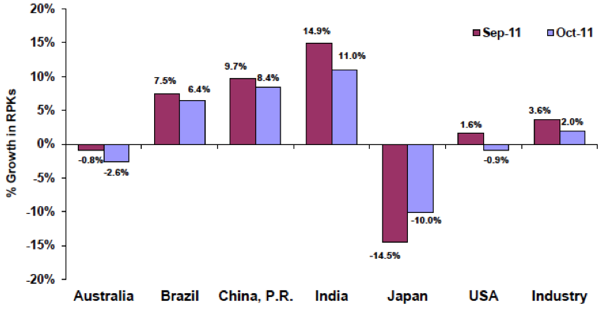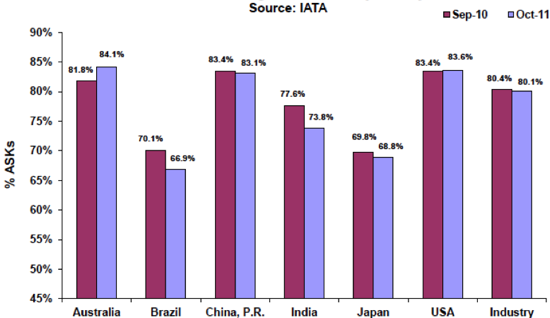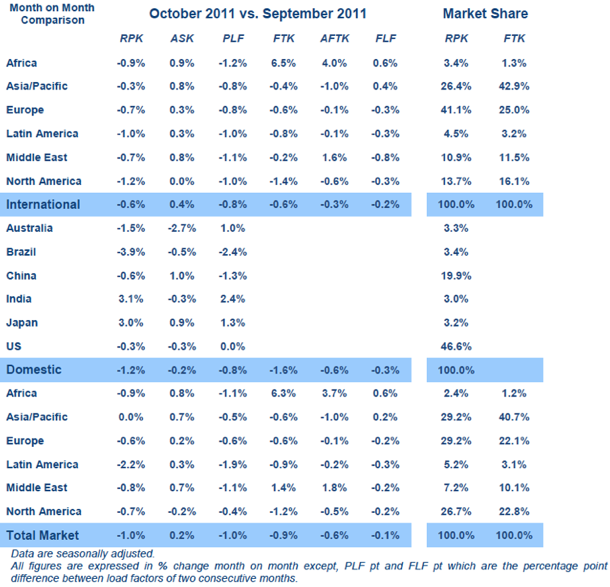Sharper downturn in air travel expected in months ahead but upward trend in Oct-2011: IATA
In stark contrast to the decline in airfreight growth in Oct-2011, the trend for passenger air travel remained upwards in Oct-2011, but with very strong regional differences and weakening growth rates, IATA stated this week. IATA also cautioned that a "sharper slowdown in air travel is likely in the months ahead", amid continued weakness in freight and economic markets and consumer confidence levels.
Global passenger traffic (RPKs) growth slowed to 3.6% in Oct-2011, with traffic growth rates weakening from the 6% average in the first 10 months of the year and a growth rate of 5.6% in Sep-2011. However, this decline in the year-to-year comparison was partly due to a spike in travel in Oct-2010, IATA said. International traffic, at 4.6% growth, was stronger than the 2.0% increase in domestic traffic in the month. Meanwhile, load factors weakened by 1.9 ppts to 77.6%.
IATA total (domestic and international) passenger market traffic (monthly RPKs, billion): Jan-2006 to Oct-2011
IATA total (domestic and international) passenger load factors (% ASKs) (seasonally adjusted): Jan-2006 to Oct-2011
Declining traffic levels in North America; strongest growth in Europe
The picture for the industry and the regions across both domestic and international markets reveals declining traffic levels at North American airlines, as the region's airlines focus on capacity caution and yield and load factor improvements. European airlines have seen the fastest growth of the major regions, with growth of 9.1%, outpaced slightly by Middle Eastern airlines (+9.2% year-on-year). African airlines have continued to lag as a region, as growth in traffic carried remains relatively weak and load factors relatively low.
IATA total (domestic and international) passenger growth (RPKs % growth) by region: Sep-2011 to Oct-2011
IATA total (domestic and international) passenger load factor by region (% ASKs): Oct-2010 vs Oct-2011
Weakening from Sep-2011 to Oct-2011, follows stronger Oct-2010
Air travel markets also declined between Sep-2011 and Oct-2011, with domestic markets showing a larger weakness than international markets, led by declines in the US and China. Load factors are also declining, amid a renewed imbalance between demand and capacity.
IATA Oct-2011 vs Sep-2011 traffic statistics
International market stronger than domestic markets
International air travel, comprising two-thirds of the total market, weakened by 0.6% between Sep-2011 and Oct-2011 but increased by 4.6% on a year-on-year basis following growth of 6.8% in Sep-2011. IATA noted the trend in international traffic suggests that "the direction of travel is still upwards but its pace is slowing".
IATA international passenger market traffic (monthly RPKs, billion): Jan-2006 to Oct-2011
Internationally, North American airlines are cutting international capacity, resulting in declining traffic levels. North American carriers were the only region to see declining traffic levels in Oct-2011, with a year-on-year traffic decline of 1.9%. In North Atlantic markets, US airlines have reduced capacity while AEA airlines have been adding capacity at a rapid pace of over 9% p/a in Oct-2011, IATA said.
IATA added that "half of all growth of capacity and traffic carried on international markets over the past year have been added by European airlines, in spite of the damage to originating traffic being done by the eurozone crisis". Meanwhile, the strongest passenger segments over the past year have included the North Atlantic and within-Europe. "Much of this is likely to have been business travel generated by the strong export performance of Northern European economies," IATA said.
IATA international passenger growth (RPKs % growth) by region: Sep-2011 to Oct-2011
Asia Pacific, the third largest region, has seen "modest" performance, "in between the experience of the North American and the European airlines", IATA said. The region's airlines witnessed strong post-recession growth, amid a rebound in manufacturing activity and business travel, but growth has slowed in the past 12 months, reflecting a slowing in Asian export activity.
European carriers also saw a passenger load factor of 80.2%, despite its above-average growth rate, for the strongest regional load factor. North American airlines also reported load factors of over 80% in Oct-2011, exceeding the industry average of 77.6%.
IATA international passenger load factor by region (% ASKs): Oct-2010 vs Oct-2011
IATA international passenger load factors (% ASKs) (seasonally adjusted): Jan-2006 to Oct-2011
China domestic market to double in size every seven to eight years based on current trends; US remains largest domestic market
During Oct-2011, the month-on-month decline in domestic traffic was larger than the declines in international traffic. Overall, the trend growth rate is around 2%, a "very marked" slowdown from 8% plus growth during the post-recovery period.
IATA domestic passenger market traffic (monthly RPKs, billion): Jan-2006 to Oct-2011
As expected, there were considerable variances in domestic market growth. As has been the case of late, the US domestic market continued to enact cautious capacity growth while still representing almost half of domestic traffic. China, the second largest domestic market, saw little growth in Oct-2011, but a year-to-date growth rate of over 10%. IATA continued: "At this rate the market will double in size every 7-8 years."
Among the world's other fastest growing domestic markets, both Brazil and India continue to report strong growth. Brazil has slowed in recent months but was up more than 15% so far this year (a pace that would double the size of this market in five years). India has also slowed a little, reflecting the slight economic slowdown in the region, but has expanded by over 17% in the year-to-date period.
Japan's domestic market is still recovering from the 11-Mar-2011 earthquake and tsunami, which caused the market to shrink by more than a quarter. The level of traffic still remains 7% below pre-earthquake levels.
IATA international passenger growth (RPKs % growth) by region: Sep-2011 to Oct-2011
In terms of load factors, Chinese airlines have seen considerable load factor improvement, with load factors of above 83%, marking around an 8 ppt growth rate over the past three years. This has had a positive flow-on effect on profitability. Load factors have not been as positive in Brazil, with this being a contributing factor to the recent losses of domestic airlines on this market. High load factor levels on the US domestic market have helped US airlines in their performance over the past year.
IATA domestic passenger load factors (% ASKs) (seasonally adjusted): Jan-2006 to Oct-2011
International passenger load factor by region (% ASKs): Oct-2010 vs Oct-2011
Uncertain outlook for 2012
As echoed by airlines and economists around the world, the outlook for 2012 is "uncertain". The current weakness is generally expected to continue into the New Year amid continued declines in business and consumer confidence, economic concerns in the euro zone and a stagnation in the freight sector. These factors also suggest the strength of the passenger market could be at risk. Meanwhile, with continued capacity additions occurring amid the weakening demand conditions, load factors, utilisation rate and yields and cost inputs rising, breakeven load factors and profitability are expected to rise, particularly in cargo operations.
However, IATA has previously stated that despite the uncertain and rocky outlook, airlines are not expecting a fall in demand similar to that in late 2008. "The exception is for cargo markets, which appear to have been driven by recent experience. Passenger markets were relatively robust in the third quarter, and most airlines expect that to continue in the year ahead," it has said.
APPENDIX
IATA Oct-2010 vs Oct-2011 traffic
IATA Sep-2011 vs Oct-2011 traffic














